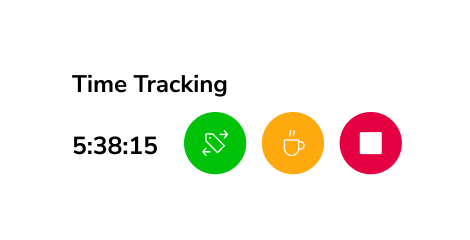5 Best Time Tracking Practices for IT Professionals
Before a project can be deployed, it goes through a long list of complex stages. From planning, design, coding, and testing, deadlines can be tight. This leaves little room for error or delay.
If you want your project to stay on track, you will need to monitor how time is allocated and spent at every step. Time tracking best practices for IT professionals can help you do just that.
In this article, we’re going to outline strategies that will better equip you to manage your workload, prevent bottlenecks, and deliver successful projects that meet deadlines and exceed expectations. Let’s get into it!
Why is Time Tracking Important for IT Professionals?
IT professionals deal with various challenges in their work. They handle multiple projects at the same time, switch between diverse tasks, and organize their own time. Time tracking allows IT professionals to monitor how they spend their time, improve effectiveness, and make smart choices to streamline their work.
When you track time, you can assess your work and performance, which lets you boost your output and quality. This in turn helps you set clear goals and milestones for your projects and create a time management system that suits you and your work style.
Apart from that, time tracking helps ensure compliance with labor laws and regulations around working hours and pay, promoting fair and ethical practices. Finally, it provides valuable insights into your work patterns, enabling data-driven decisions that can boost productivity and support a healthier work-life balance.
Photo by fauxels on Pexels
Time Tracking Best Practices for IT Professionals
Good time tracking habits empower IT professionals to optimize performance, meet targets, and reduce burnout. This section outlines key best practices that help turn time data into actionable insights—so you can work smarter, not harder.
Tip #1: Optimize your work time
As an employee or a contractor, tracking your own time can help you manage your work effectively. Use time tracking software that streamlines the process and provides you with useful information about your work. Follow these practices to track your own time better:
- Use the Eisenhower Matrix to prioritize tasks: The Eisenhower Matrix is a helpful tool that can help you choose which tasks to do first based on how important and urgent they are. You start by putting tasks into four sections – important and urgent, important but not urgent, urgent but not important, and not important and not urgent. This helps you quickly see what needs to be done right away and what can be delegated or done later.
- Break tasks into smaller chunks: dividing work into easier and smaller tasks will make a big project more approachable. This is especially helpful when working on complex IT projects that encompass many parts, tools, and people. Chunk tasks into smaller steps, and focus on each part, one by one, to make it easier to use your time and resources well.
- Use time-blocking methods: One of the best ways to manage your time as an IT professional is time-blocking methods like the Pomodoro Technique. Allocate a specific amount of time—such as 30 minutes or an hour—for each task, and use a timer to stay on track. Scheduling specific time blocks helps minimize distractions and interruptions, especially from things like social media or incoming messages. Don’t forget to take short breaks between sessions to give your brain time to rest and recharge.
- Limit multitasking: You may think that doing many things at once is a good way to use your time, but a 2024 multitasking study conducted on 265 undergraduates indicated that multitasking negatively impacts performance across a wide range of tasks. Instead, focus on finishing one thing at a time before starting the next. This will help you stay focused and make sure that each thing is done well and fast.
Tip #2: Improve project tracking
“Quality is never an accident; it is always the result of intelligent effort.” – John Ruskin, Victorian writer and polymath
IT professionals often juggle multiple projects, each with its own level of complexity and priority. Use project tags in your time tracking software to sort your time entries based on different projects or tasks. This allows you to see the time spent on each project or task, identify quality issues, and make improvements.

Photo by Christina Morillo on Pexels
To use project time tracking effectively, you should follow these best practices:
- Define clear and consistent project tags that reflect your expectations, goals, and priorities.
- Assign project tags to each time entry as soon as you start working on it, or use a timer that automatically adds the tags for you.
- Review your project tags regularly to ensure they match your quality standards, and update them if necessary.
- Use reports and dashboards to visualize and analyze your project data.
Tip #3: Choose the right time tracking software
You should select time tracking software that caters specifically to the needs of IT professionals. Choosing the right software will improve your time tracking process and enhance your efficiency. You should consider factors such as:
- Compliance with labor laws and regulations regarding working hours and pay.
- Integration with other IT tools that you use.
- Customizable reporting features that show time on your projects.
- Ease of use and speed of the software.
- Cost-effectiveness of the software.
See our roundup of The 6 Best Time Tracking Software.
Tip #4: Streamline IT management
Compliance with labor laws and accurate record-keeping is essential for IT managers. Dedicated time tracking software that integrates with payroll and other systems simplifies reduces mistakes, and administrative processes, ensures compliance, and reduces overhead costs.
Another benefit of using time tracking software is that it can help you measure the productivity of each team member working on a project or a task. This adds a layer of accountability for everyone involved and improves efficiency levels.
For example, you can see what your employees or contractors achieved that day, which tasks they had difficulties with, etc. Detailed productivity reports can help you identify training needs and reward those employees or contractors that excel.
To use time tracking software effectively for management and productivity, you should follow these best practices:
- Use time tracking software that meets your needs and preferences, and integrates with your other tools and systems.
- Talk with your team members about why and how time tracking helps you, and ask them to agree and work with you.
- Train your team members on how to use the time tracking software correctly and consistently.
- Review your time tracking data regularly, and use it to make informed decisions and actions.
Tip #5: Gain insights through data analytics
Time tracking data provides valuable insights for IT professionals. By using data analytics tools, you can evaluate your performance, find areas for improvement, and make data-driven decisions. See how you use your time for different projects, tasks, clients, or categories, and find patterns or trends.
Align your time use with your goals and priorities, and adjust it with your budget. Analyze your time tracking data to optimize your workflow, enhance productivity, and boost your impact.
To use data analytics tools effectively for time tracking, you should follow these best practices:
- Define clear and measurable goals for your time tracking data analysis and check that your project tags reflect these metrics.
- Collect your time tracking data in a secure way.
- Use data visualization techniques to present your data in a clear and engaging way.
- Use data analysis techniques to interpret your time tracking data and draw meaningful conclusions.
- Use data storytelling methods to communicate your insights and recommendations to others.
Final Thoughts: Revolutionize Time Tracking for IT Professionals
Time tracking helps me use my time well, work better, and reach my goals as an IT professional. By following these best practices, you also can gain control over your schedules, optimize your work processes, and achieve success in your projects.
Embracing time clock software, adhering to labor laws, and using data analytics will revolutionize your time tracking practices and lead to personal and professional growth.
Related Articles:
26 Time Tracking Best Practices to Boost Your Productivity
Best Inspirational Time Management Quotes to Live By
6 Best Time Management Strategies for Consultants


